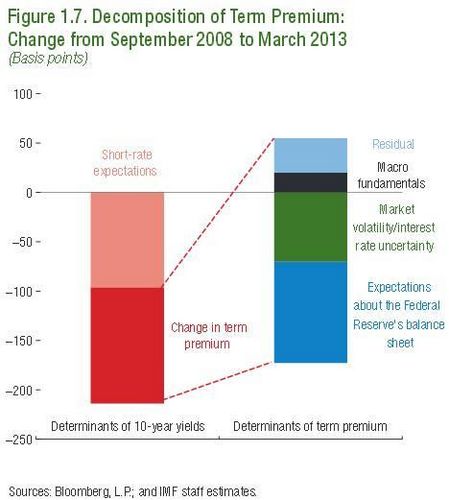
Divyang Shah, IFR Senior Strategist
The move up in 10-year Treasury yields since May has come about as markets adjust to a new outlook for unconventional and conventional policy. Just how much of an impact did QE and forward guidance have on the 10-year yield will help us to answer the question as to how much further adjusting is left to be done.
When nominal interest rates are at the zero lower bound the Fed still has a few tricks up its sleeve via unconventional policy of forward guidance and QE in order to lower term premia.
The IMF in its latest Global Financial Stability report breaks down the decline in nominal 10-year Treasury yield between Sept-2008 to Mar-2013. They find that the 200bps decline in 10-year yields is almost equally related to short-rate expectations and a decline in term premia.
When the term premia element is broken down further then the main contributors are a decline in market volatility/interest rate uncertainty as well as expectations on the Fed’s balance sheet.
The IMF highlights that the rise in 10-year yields since May-June was largely a function of an increase in term premiums rather than short-rate expectations.
The analysis by the IMF contributes toward our understanding of the extent to which Fed policy has contributed to lower Treasury/mortgage rates.
The challenge for the Fed (and its communication) is to create a smooth adjustment of market pricing when the time is ripe to take the foot off the monetary accelerator.
The communication fail heading into the September FOMC meeting is a sign that the Fed has yet to clearly grasp the communication challenge.
The key for 2014 will not only be about the speed at which QE ultimately ends but also whether the Fed can persuade markets that policy will stay accommodative as the Fed is in no hurry to return rates to the 4% neutral level despite its unemployment and inflation forecasts.
